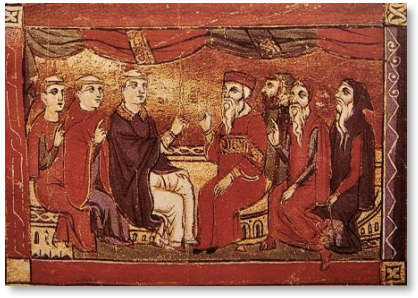Schism with the West
In 330 A.D., the Emperor Constantine moved the capital of the empire to the newly created city of Constantinople (on the site of the older city of Byzantium), which was called the “New Rome." This decision was to have far-reaching consequences. As the new seat of government, the city grew to have increased importance in the Church as well, changing the status quo. The bishop of Alexandria formerly had the second place among the bishops, after the bishop of Rome. Now the second place belonged to Constantinople.
The Roman empire came to have two loci of power, one in the west (centered in Rome), and one in the east (centered in Constantinople). Eventually, given the vast distances separating west from east, the western churches and eastern churches came to live their lives in comparative isolation from each other—distance being accentuated by difference of language. St. Augustine, for example, a giant among the bishops of the west, could speak no Greek. That meant that efforts among bishops as they strove to reach theological consensus over matters of Christology were greatly hampered.
Eventually the east and west grew even further apart, and with the effective collapse of Roman political power and stability in the west, the western churches were obliged to find such stability as they could among the new non-Roman rulers. The Roman emperor in Constantinople was too far away to provide the needed stability and security; other arrangements would have to be made. It was because of this new situation that the bishop of Rome threw in his political lot with the so-called “Holy Roman Empire” of Charlemagne and his successors.
Within this new situation, the city of Rome and its bishop had a unique role. In the eastern region, Rome, though having the primacy, was but one apostolic church among others, and the bishops of Alexandria, Constantinople, Antioch, and Jerusalem all had their roles to play in reaching a universal consensus. In the west, Rome stood alone, towering over the other episcopal sees. At length, the prestige and authority of the see of Rome came to count for more than consensus. Bluntly put, the bishop of Rome became accustomed to being obeyed. It worked well enough (more or less) in the west, where Rome provided a much-needed haven of stability. In the east, the results of Rome’s selfpromotion were more mixed.
The churches of the east and west disagreed and quarrelled over many things, some more significant than others. They came to differ over the content of the Creed, with Rome (after resisting the innovation for some time) eventually reciting the Creed with the additional word “filioque” inserted, thereby declaring that the Spirit proceeded from the Father and the Son. East and west also differed and fought over liturgical usages, such as the possibility of a married clergy, and the use of unleavened bread in the Eucharist.
Underlying all these quarrels and impeding their speedy resolution, were differing models of how such decisions were to be reached, though this insight about the underlying problem was not fully recognized at the time. In the west the authority of the bishop of Rome was seen as key to unity, whereas in the east the churches continued to use the older model of unity through consensus. This underlying and unacknowledged difference expressed itself in a quarrel between the bishops of Rome and Constantinople in 1054 so that those bishops broke communion with each other. Though not constituting a schism between the entire west and the entire east, the date 1054 came to have symbolic value, expressing the definitive break. From the beginning of the second millennium onwards, the churches of east and west ceased to regard themselves as belonging to the same family. East and west lived their lives in virtual isolation from each other, scarcely speaking to one another as they did formerly, and understanding each other even less.
From the beginning of the second millennium onwards, the churches of east and west ceased to regard themselves as belonging to the same family. East and west lived their lives in virtual isolation from each other, scarcely speaking to one another as they did formerly, and understanding each other even less.